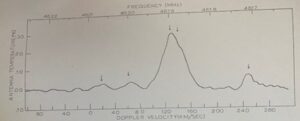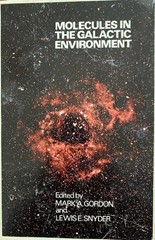In the late 1960s, clouds of molecules such as hydrogen (H2), water (H2O), ammonia (NH3), and formaldehyde (H2CO) were just being discovered in interstellar space. Dr. George Swenson Jr., an electrical engineer, was head of the Astronomy Department at the University of Illinois. Dr. Willis Flygare, a physical chemistry professor, was researching molecular properties using microwave spectroscopy. As molecules rotate, they emit spectral lines of microwave radiation.
New interstellar molecules were being discovered by pointing a radio telescope toward molecular clouds in interstellar space and capturing rotational spectral lines in the microwave frequency range emitted by the molecules.
The interstellar molecules found in the late 1960s were primarily small molecules comprised of a half dozen atoms or less. A list of small molecules thought likely to be found in intergalactic clouds was quickly prepared. The problem was the microwave spectra for most of these candidate molecules had not yet been calculated or measured so radio astronomers did not know to which frequencies to tune their radio telescopes.
In 1970, Dr. Swenson approached Dr. Flygare with a proposal to collaborate on a project to detect new interstellar molecules. Dr. Flygare’s group would use their computer programs to calculate the frequencies of the spectral lines for candidate molecules and their collaborative team would search for these spectral lines using radio telescopes such as the 140-foot radio telescope at the National Radio Astronomy Observatory (NRAO) in Greenbank, WV (Figure 1).

In March of 1971, on one of their observation trips, team members Bob Rubin, Richard Benson, and Howard Tigelaar scanned the frequency range between about 4.615 and 4.625 GHz searching for spectral lines emitted by rotating interstellar formamide (NH2CHO) molecules. They worked 3 nine-hour shifts for several days constantly capturing the microwave signals with NRAO’s radio telescope dish and recording the microwave signals on large magnetic disk packs.
Because signal noise is much greater than the intensity of emitted spectral lines, the University of Illinois team saw nothing throughout their long days and nights of observation. After completing their observations, they drove the disk packs from Greenbank, WV over the mountain pass to the NRAO data processing facility in Charlottesville, VA. There, NRAO computers averaged the data on the disk packs together. Since noise is random whereas the spectral lines are constant, the random noise averages away while the spectral lines remain.
A week or so after completing their observations, it was back in their office on the second floor of Noyes Lab that the team first discovered they had detected three rotational spectral lines from interstellar formamide molecules (Figure 2). For verification, Benson and Tigelaar hand built an L-band microwave spectrometer in the basement of Noyes Lab and measured the positions of the three formamide spectral lines. Their in-lab measurements matched exactly with the spectral lines captured by the radio telescope.

The Illinois team’s discovery created quite a stir in the scientific community. Formamide was the first interstellar molecule with four elements and the first-time hydrogen, carbon, oxygen, and nitrogen were all in the same molecule. The formamide molecule is the main building block for amino acids from which DNA and RNA molecules, the molecules of life, are constructed.
This discovery sparked a rush by teams from other universities to confirm their finding. Later the same year a team of radio astronomers from the University of Chicago, Harvard University, and University of Maryland published that they had observed the 111 -> 110 formamide spectral line at 1.54 GHz on page 499 of the Bulletin of the American Astronomical Society.
Upon announcement that a University of Illinois team had discovered a cloud of formamide in outer space, news articles soon appeared. The Boston Globe published an article announcing the discovery in their April 8, 1971 issue. A major weekly news magazine, Newsweek, also published an article in their Science section in 1971.
Two of the primary publications from this discovery were:
- Flygare, W.H., Benson, R.C., Tigelaar, H.L., Rubin, R.H., & Swenson Jr., G.W. (1973). Chemical and Rotational State Stability of Interstellar Formamide. In M.A. Gordon & L.C. Snyder Molecules in the Galactic Environment (pp. 173-179). Wiley-Interscience Publication.
- Rubin, R.H., Swenson Jr., G.W., Benson, R.C., Tigelaar, H.L. & Flygare, W.H. (1971). Microwave detection of interstellar formamide. The Astrophysical Journal, 169, L39-L44. https://adsabs.harvard.edu/pdf/1971ApJ…169L..39R
Howard Tigelaar recalls a story George Swenson told him, while a graduate student and traveling to conferences, about the challenges faced in building a dish telescope:
“The Astronomy Department at the University of Illinois got a large grant from the government to build a fully steerable dish telescope at U. of Illinois to search for interstellar molecules. The U. of Illinois radio telescope team had finished with the plans and had just started building it when a new U.S. president came into office and cut the grant money. I don’t remember how much of the grant money the Astronomy Department had already received, but it wasn’t much. Dr. Swensen and the University of Illinois Astronomy team decided to build it anyway.
The most expensive part of the telescope they could not afford to buy was the large screw that controlled the inclination of the dish. I’ve forgotten how big the dish was – maybe 20 feet or so across? Through his buddies in the army and military, Dr. Swensen was able to find surplus machining equipment such as a huge lathe, a huge milling machine, and huge pipe bending equipment – either donated to the university or at very low cost. The telescope team machined their own parts for the telescope including machining the large screw. They also bent pipes to make the perfect parabolic frame required for the fully steerable dish. Working with the physics department, they designed and hand built all the electronics needed to drive the telescope and the radio receiver to capture the radio signals. The also designed and built the electronics needed to generate a radio spectrum from the captured radio signals. I remember seeing the console they put the electronics in. They built the electronics in an old surplus metal office desk. When you pulled a drawer out, it was filled with circuit boards stacked vertically one behind another from the front the drawer to the back of the drawer. Truly amazing what the University of Illinois Radio Astronomy Team was able to accomplish on such a small budget!”
- Noyes Laboratory – where the team discovered and verified they had discovered formamide in space.
Flygare, W.H., Benson, R.C., Tigelaar, H.L., Rubin, R.H., & Swenson Jr., G.W. (1973). Chemical and Rotational State Stability of Interstellar Formamide. In M.A. Gordon & L.C. Snyder Molecules in the Galactic Environment (pp. 173-179). Wiley-Interscience Publication.
Newsweek. (1971, April 26). Gold Mine in the Sky. Newsweek, 77(17). 56, 59
McElheny, V. (1971, April 8). Earth chemical discovered in Milky Way. Boston Globe, 6.
Palmer, P.; Gottlieb, C. A.; Rickard, L. J.; Zuckerman, B. (1971) Detection of the 111– 110 transition of interstellar formamide. Bulletin of the American Astronomical Society. p 499. https://adsabs.harvard.edu/pdf/1971BAAS….3..499P
Rubin, R.H., Swenson Jr., G.W., Benson, R.C., Tigelaar, H.L. & Flygare, W.H. (1971). Microwave detection of interstellar formamide. The Astrophysical Journal, 169, L39-L44. https://adsabs.harvard.edu/pdf/1971ApJ…169L..39R

